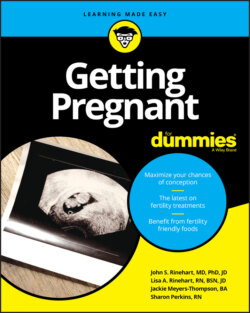Читать книгу Getting Pregnant For Dummies - Sharon Perkins - Страница 71
Karyotyping
ОглавлениеThere are a number of tests that are used to gain information about a person’s genetic code. One test, called karyotyping, determines how many chromosomes are present. This can be done for people, a fetus, or embryos.
Remember that the chromosomes are long strings of genetic code that are tightly packaged, and there are 23 sets of chromosomes. Chromosomes 1–22 are called autosomes, while 23 is the sex chromosome. Each person has one set of chromosomes from each parent so there are 46 chromosomes arranged in 23 pairs. The sex chromosomes determine the sex of the person with XX being female and XY being male.
Until recently, testing chromosomes was laborious with cells being grown, stopped in their development, stained, photographed, and then counted. This process required a number of cells to be tested and was most commonly associated with an amniocentesis. The amniocentesis was done during the early second trimester to diagnose the presence of an abnormal number of chromosomes such as Down syndrome, which is trisomy 21, where the fetus has three copies of chromosome 21 (instead of two).
Recent developments in data analytics and molecular biology (next-generation sequencing) have permitted rapid chromosome determination in only a few cells (4–6) that can be taken from a five-day-old human embryo. The test is called preimplantation genetic testing for aneuploids. What’s an aneuploid? Glad you asked. When a cell has the correct number of chromosomes, it is called a euploid cell. But a cell can have too many chromosomes because it has the wrong number of sets of 23, such as a monoploidy or triploidy. If there is an incorrect number of any single chromosome, such as only one X chromosome (remember Turner’s syndrome with 45 XO or trisomy 21 with three number 21 chromosomes so 47, 21 +3), the cell is called an aneuploid cell. The value of karyotype testing is that it permits embryo selection such that embryos with the correct number of chromosomes can be transferred. This type of testing cannot correct the number of chromosomes an embryo has, so it does not increase the number of children that can result from an IVF cycle. But it can permit the transfer of embryos that have the highest chance of creating a pregnancy that can go to term. This reduces the time to conception and reduces the miscarriage rate.
There is controversy as to whether the use of preimplantation genetic testing for screening embryos is indicated, but many physicians and patients are opting for this diagnostic procedure. For some couples, the information from testing for chromosome number can help identify why a person has not conceived and may suggest either doing more cycles of IVF with the woman’s own eggs or may identify the need to move on to other options such as stopping treatment, adoption, or using donor eggs.
